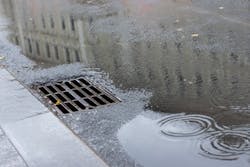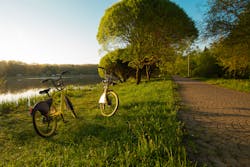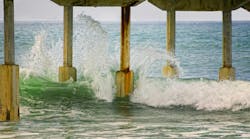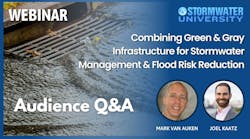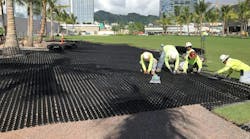Is effective and equitable stormwater management a public health concern? Elva Yañez, director of health equity at Prevention Institute (PI), thinks so. She has been working with PI and Los Angeles County to improve stormwater infrastructure in disadvantaged communities for years and hopes other communities and agencies will follow suit.
Yañez started working in public health in the late 1980s with issues like tobacco control and alcohol problem prevention. She became involved in park and open space issues in the early 2000s, which is when she was introduced to PI.
The Prevention Institute’s name may seem a little vague, but the national nonprofit focuses on health equity and prevention, with the goals of health, safety, and well-being for all communities. “Our goals are broad, and they’re interrelated, going beyond the notion of healthcare or the absence of illness,” says Yañez. “As for equity, we believe that regardless of where people live, the color of their skin, or the amount of money that they earn, they should have a fair and just opportunity to be healthy.”
Yañez describes PI’s work as “upstream prevention.”
“We look at the policies and practices that create inequities in the first place and then shine spotlights on the solutions, whether that’s policy, practice, procedure, or systems change,” she says.
It was this set of values that attracted her to PI and led her to serve on the board before joining the staff in 2015. “There was a strong alignment in terms of addressing public health from a social determinant of health standpoint,” she says.
Think of social determinants of health as very early preventative medicine. They can include income and education level, race, access to safe housing and local food markets, and the quality of the infrastructure in your community, among other things, and often tied to the conditions in your immediate community.
Yañez says these social factors influence our health much more than most people think. “Where you live is a better determinant of health than almost everything else,” she says. Things like cancer or heart disease screenings, which we generally consider preventative medicine, may catch diseases early but do nothing to address the health risk linked to living near a freeway. The addition of accessible parks and other green spaces, on the other hand, might.
Measuring Stormwater
Yañez’s move from parks and open space to stormwater came when she was invited to take part in a stormwater education program tied to a 2013 ballot measure in Los Angeles County.
“I learned a lot about the dynamics of stormwater public financing and the relationship between stormwater and health. It was striking to me how stormwater regulations have a strong basis in public health, but there is very little orientation to public health when it comes to stormwater management or public financing for stormwater management systems,” she says.
Becoming involved in stormwater equity felt natural to Yañez. “It was like the connective tissue between parks and open space were the equity issues and the green stormwater infrastructure overlap,” she says.
Although the 2013 measure never went anywhere, LA County eventually ended up with Measure W, or “The Safe, Clean Water Act,” which was passed in 2018 and established a tax on impermeable areas within the LA County Flood Control District (District). “Measure W generates over 300 million per year for stormwater infrastructure, including nature-based and green infrastructure,” says Yañez.
In 2017, during the development of Measure W, Yañez was brought in again, this time as part of a public engagement process in hard-to-reach or rarely reached communities.
“We were doing outreach to marginalized and disinvested communities; the folks who are heavily impacted by flooding in their communities have very little or very poor-quality flood control infrastructure. They have very few parks and open spaces, low income, low education levels,” explains Yañez. “Those are the folks who live in disinvested communities, and they’re also the least likely to be reached by traditional community engagement efforts.”
Not long before she began working on Measure W, Yañez and colleagues from Prevention Institute were invited by the Water Foundation to develop a paper exploring water health and equity in Los Angeles County. Although it wasn’t specifically for Measure W, the two projects happened to coincide.
In developing the paper, Yañez and her colleagues started by interviewing a broad range of people in the environmental justice community and stormwater experts. When asked what they saw as the biggest area of disparity in LA County related to water, the environmental experts all said drinking water.
“When we looked at the stormwater issue, it was fascinating that stormwater folks didn’t really have a clear picture of stormwater inequities,” she says. According to Yañez, that’s at least in part due to how little has been written about the issue. “All these factors serve as barriers to elevating the issue of stormwater equity in a way that practitioners can implement.”
The paper, A Time of Opportunity: Water, heath, and equity in the Los Angeles Region, co-authored by Yañez, Rachel Bennet, Eric Bruins, and Manal J. Aboleata, was published in July 2018, just months before Measure W was voted on and passed in November of the same year.
In addition to generating funds for stormwater infrastructure, the Measure also includes what Yañez calls an “equity set-aside.” In Los Angeles, explains Yañez, “there’s a lot of overlap between the park and open space equity advocates and the folks who work on stormwater, so there’s been sort of a natural osmosis—no pun indented—between those networks.” As a result, there were many advocates, including PI, pushing for equity to be included in Measure W.
Because green stormwater infrastructure can provide a variety of benefits beyond stormwater infiltration and treatment, including improved air quality, heat reduction, and neighborhood beautification, it’s easy to end up overserving higher-income areas, or at least underserving lower-income neighborhoods.
As part of Measure W, according to the Safe, Clean Water Program website, “Regional Infrastructure Program Funds must be allocated such that funding for projects that provide benefits to Disadvantaged Communities (DAC) are at least 110% of the ratio of the DAC population to the total population in each Watershed Area.” The Measure’s public and school education and local workforce job training programs also have a mandate to pay special attention to the needs of DACs.
“The fact that [the Measure] actually endeavored [to include]—and ended up with—an equity set-aside was significant,” says Yañez. “We feel our paper had a lot to do with grounding the advocacy for that.”
Defining Disadvantage
Yañez now sits on the Safe, Clean Water Program Regional Oversight Committee (ROC), which is responsible for assessing whether the Program goals are being met. When we spoke last year, the Committee was preparing to work on defining and measuring what a “disadvantaged community” means.
“There just aren’t a lot of best practices out here on equity,” she says, “so they’re being developed right here in Los Angeles, right now.” Although there are other places like Philadelphia that have done good work, overall “there’s very little written about it, and as long as there’s very little research happening on this issue, not much will evolve,” she says.
Yañez is familiar with how issues like stormwater equity go from relative obscurity to receiving the research and attention they deserve. “When I started working in parks and open space, there was very little being written about equity and parks. But there was a lot of research that started getting funding on the relationship between parks and physical activity levels,” she says. “Stormwater is a newer issue to those same funders and it’s only now starting to be looked at as an adjunct issue to parks and open space.” Stormwater infrastructure, especially green stormwater infrastructure, is and should be understood as basic community infrastructure.
Looking at how stormwater has been treated in Los Angeles throughout history tells a story of the changing approaches promoted by stormwater advocates through time, says Yañez. At first, she explains, the focus was on making sure beaches were clean and not accumulating trash. But a beach-centric approach “is really different from saying that stormwater pollution should be eliminated from all neighborhoods and that pooling water, flooding, and lack of green space are problems that a comprehensive, integrated approach to stormwater should address,” she says.
A more equitable program would have everyone in a county pay to make a variety of improvements (as part of a stormwater finance measure like Measure W, for example), even those without any benefits as visible as clean beaches. For those who live in disinvested communities, stormwater infrastructure benefits are seldom seen in their neighborhoods.
While Yañez says the equity benefit in Measure W given to DACs was all well and good, “there’s no data to say where in the disadvantaged communities people are experiencing stormwater risks, nor are there data that demonstrate or point to opportunities, which are usually two sides of the same coin.”
To address this while the Measure was being crafted, Prevention Institute encouraged the creation of a database or GIS map, like what Los Angeles County Parks and Recreation developed for park inequities. “They created a heat map showing where there were the fewest park infrastructure units and other factors that increased the inequities,” explains Yañez. “As part of my involvement with the ROC, I and other equity advocates on the Committee have pushed for doing some sort of mapping that will at least allow people who are developing projects that they want funded by Measure W to say, ‘This is the problem we’re solving in the DAC.’”
With a database or GIS map, Yañez says stormwater issues could be more accurately identified and addressed. “Just doing a project in a DAC is not a good use of taxpayer money,” she says. “There have to be evidence- and data-informed expenditures as well as evaluation further down the line to make sure that projects are meeting the goals and objectives.”
A Public Health Risk
Some of the health risks associated with stormwater are more obvious than others. Of course, Yañez says, at the beach there’s a risk of exposure to toxic effluents, gastroenteritis, and respiratory illness. Further upstream, poor stormwater infrastructure can lead to pooling water, which can lead to mosquito infestations and infectious disease.
“These problems in disinvested communities coincide, so where you have those problems, you also have places where there are no parks or open spaces. Then, kids are playing in the channelized rivers after or even during a storm and being exposed to everything in the water,” she says.
But the biggest problem is flooding. “Wherever there’s flooding, you’re probably going to find a low-income community of color,” says Yañez, “and that’s where the infrastructure needs to be improved or installed in the first place.” South and Southeast LA, which are low-income communities predominantly made up of people of color, are two areas that have major problems with flooding, she says.
Yañez encourages stormwater managers and local and state officials to look at flooding as one indicator of inequity but also to map out other inequities. “If you look not only at the stormwater risk but then also at income, health status, educational levels, language isolation, exposure to other environmental hazards, those types of things together, you’ll start to be able to generate evidence-based approaches to stormwater equity,” she says.
Looking at these other factors is key. Take income, for example. As the cost of flood and wildfire insurance rises in California in response to rising sea levels and increasingly severe fire seasons, the impact will be very different for low-income Californians than wealthy ones. Losing your home is an unmitigated tragedy no matter who you are; having the means to purchase a new one certainly matters.
“More affluent homeowners who live on the urban fringe also experience higher levels of flooding,” Yañez points out, “so the analysis has to include income and race.”
Once you know where inequity exists, the next step is to prioritize resources for those communities “because you can’t fix those problems through education,” she says. “You could get better engaged communities, but you’re not going to fix the problem.”
Yañez says a good place to start is with an equity analysis of your community’s stormwater issues to gather the relevant data. “Start looking at things like flooding, where the money is going for infrastructure improvements, what kinds of improvements those are, and whether they are equitably distributed,” she says.
Then, she recommends contacting environmental groups like local Baykeepers, The Trust for Public Land, or The Nature Conservancy who deal with stormwater and see how they approach green infrastructure equity issues.
Finally, educate yourself about the issues. Although there’s a dearth of research at the moment, Yañez says you can always conduct your own. “If there’s no data, encourage local community foundations to start funding and paying attention to that. If you can find a funder who is working on creating more parks and making them more accessible, those are the right people to approach about green infrastructure and stormwater. And they can read our paper!” she laughs.
Although there’s never a bad time to address inequity in your stormwater program, the moment may be particularly ripe right now. “At this moment of the triple pandemics—COVID, economic downturn, and racial uprising—the idea of structural inequities has become more mainstream,” says Yañez.
Attempting to address inequity in your stormwater program can seem daunting, but the results—improved water quality, and healthier and better served communities—are worth the effort. Too often, disadvantaged communities feel the negative effects of ineffective or insufficient stormwater infrastructure, but every community deserves access to green space and effective stormwater management. “If you take that concept to scale in a place like Los Angeles,” says Yañez, “it could be transformative.” SW
Rachel Sim served as the editor of Stormwater magazine until December 2020, creating and curating quality content addressing the challenges faced by surface water and erosion control professionals.
Resources
Barragan, Bianca. “Measure W: LA’s parcel tax for stormwater recycling, explained.” Curbed Los Angeles. Updated November 5, 2018. www.la.curbed.com/2018/10/18/17930972/measure-w-los-angeles-ballot-measure
Centers for Disease Control and Prevention. “Proximity to Highways.” National Environmental Public Health Tracking Network. https://ephtracking.cdc.gov/showProximityToHighways.action
Fehrenbach, Jed, J.P Wilson, J. Wolch. “Parks and Park Funding in Los Angeles: An Equity-Mapping Analysis.” Urban Geography 26(1): 4–35. May 2013. www.researchgate.net/publication/261665248_Parks_and_Park_Funding_in_Los_Angeles_An_Equity-Mapping_Analysis
Prevention Institute. www.preventioninstitute.org
The Safe Clean Water Program. www.safecleanwaterla.org
US Department of Health and Human Services. “Social Determinants of Health.” Healthy People 2030. www.health.gov/healthypeople/objectives-and-data/social-determinants-health
Water Foundation. www.waterfdn.org
Yañez, E., R. Bennett, E. Bruins, M.J. Aboelata. "A Time of Opportunity: Water, Health and Equity in the Los Angeles Region," Oakland, CA: Prevention Institute. 2018. www.preventioninstitute.org/sites/default/files/uploads/A%20Time%20of%20Opportunity%20July%202018.pdf
